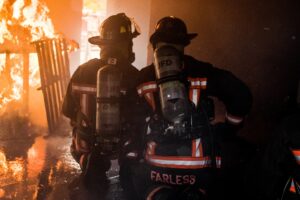Fireground Contaminants Research Study Findings Released
February 7, 2023
 While January is designated as Firefighter Cancer Awareness Month, the fight to prevent cancer in firefighters requires year-round vigilance. In September 2021, the Maryland Fire and Rescue Institute (MFRI) and the University of Maryland Department of Fire Protection Engineering were awarded a $126,488 Fire Prevention and Safety grant by the Federal Emergency Management Agency to study fireground contaminant exposure control approaches used nationally by fire departments. The results from the study are now available.
While January is designated as Firefighter Cancer Awareness Month, the fight to prevent cancer in firefighters requires year-round vigilance. In September 2021, the Maryland Fire and Rescue Institute (MFRI) and the University of Maryland Department of Fire Protection Engineering were awarded a $126,488 Fire Prevention and Safety grant by the Federal Emergency Management Agency to study fireground contaminant exposure control approaches used nationally by fire departments. The results from the study are now available.
Firefighters are exposed to a variety of contaminants during fire suppression, overhaul, training, investigation, and even while at the fire station. Routine exposure to contaminants can leave firefighters vulnerable to occupational illnesses, some of which can be fatal.
As part of the study, health and safety personnel were asked to discuss the successes and challenges they and their department have faced in developing, implementing, and managing contaminant exposure control (CEC) policies. The findings from this study uncovered the need for more research and training related to CEC.
Below are recommendations for future initiatives which will address the needs of the health and safety officer and advance the use of CEC in the fire service.
- Define an exposure. It is currently unclear what types of fires trigger the requirements for decontamination or what constitutes an exposure. Some departments only perform decontamination when there is a working fire dispatch, but what about smaller fire events like food on the stove?
- Implement CEC procedures at training academies, recognizing that procedures used by instructors and students for decontamination may be different than what is used on a scene because the hazard is more easily quantifiable in training. More research is needed to quantify hazards from training fires.
- Recognize that CEC applies to more than just the suppression firefighter, but fire investigators, instructors, and others who may be exposed to contaminants.
- Introduce new Knowledge, Skills, and Abilities (KSAs) for Firefighter 1 to include training on what is in smoke, the health impacts from contaminant exposure, the importance of decontamination, and how to decontaminate.
- Introduce new KSAs for fire officers to include a better understanding of the safety culture message and cancer awareness — safety is the most important priority.
- Introduce new KSAs to health and safety officers/incident safety officers to include methods for CEC policy development, implementation, and management; understanding products of combustion; cancer and associated health hazards; and preventative measures.
- Provide formalized continuing education resources to health and safety officers and others.
- Develop methods to evaluate exposure data to revisit and improve policies and practices.
Focusing on these initiatives will aid the fire service and health and safety personnel in furthering their programs, reducing firefighter exposure to harmful contaminants, and reducing occupational illnesses in the fire service.
View the full study at https://issuu.com/umdmfri/docs/usfa_ff_decon_final_report.

